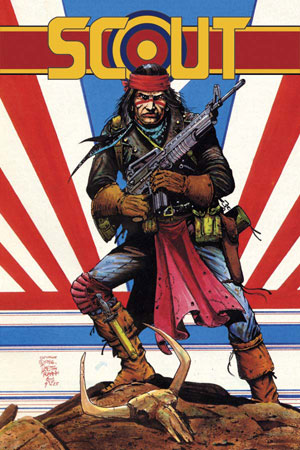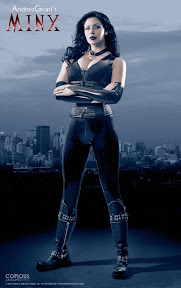Hi-ho, everyone! ☺ This portion of Indigenous Peeps in the Industry or 'IPI' - which is my on-going blog series that celebrates Indigenous artists, writers, and other creative individuals working either in the comic book or video game industry - spotlights the ever-talented, Roy Boney.
I've known Roy for some time now, have spent time with him in person, and even given presentations with him along the way. Roy is an amazing individual both from a cultural and technical (technology) standpoint, a tremendous artist, and with these great powers comes...his great sense of humor (something I definitely appreciate).
See the grin in the image for an idea of this humor. ☺
You can follow Roy on Facebook at https://www.facebook.com/roy.boney or on Twitter at https://twitter.com/royboney. Be sure to check out his homepage at http://royboney.com/. |
MS: Background info: what is your tribal affiliation and where are you from?
RB: I'm a full blood citizen of the
Cherokee Nation. I'm from Locust Grove, OK. I currently live in Tahlequah.
MS: Did you have a lot of cultural interaction growing up? (Family gatherings, dances, ceremonies, etc.?)
RB: I was raised in a small Cherokee community just outside of Locust Grove known as Iron Post. I grew up in a family of fluent Cherokee speakers. My uncles, aunts, grandparents, and parents all grew up with Cherokee as their first language. It would be spoken at family gatherings, at church, and in my house growing up.
MS: When did you first get into comics?
RB: One of my earliest memories is of going to the grocery story with my dad and seeing an issue of
Amazing Spiderman and desperately wanting it. He gave in and bought it for me. That was back in 1984 or so when
Spidey was in the black costume. I've been drawing even longer than that, and I always wanted to draw comics.
I had done cartoons for my high school newspaper, but my first real foray into publishing comics was when I was an undergraduate in college. I was studying graphic design, and getting into web design. To help me learn
HTML and dynamic scripting, I set up a website to publish a webcomic. This was around 1999, and the comic was called
Plugin Boy.
Plugin Boy is the story of a suicidal robotic boy who could only live life when he was plugged into a wall. He would constantly unplug himself only to be plugged back in by his scientist creator.
Plugin Boy developed a cult following, and I opened a small online shop that sold stickers. That grew into being contacted by a writer from Canada by the name of Matt Shepherd. He hired me to draw a webcomic series called
The License. That was my first paid gig as a comics artist.
From there Matt and I collaborated further and developed
Dead Eyes Open, a limited issue series about what would happen if zombies were not mindless flesh eating monsters but instead retained their memories, personalities, beliefs, etc., of when they were alive. Essentially they were people except for the rotting flesh part. We made a submission packet of 8 complete pages of the comic, and submitted it to as many indie comic publishers as we could. We received many rejection letters until Dan Vado over at
SLG Publishing liked the concept. They published the 6 issue series and eventually collected the series into a graphic novel.
 MS: Do you have a favorite comic; title or type?
MS: Do you have a favorite comic; title or type?
RB: Some of my most favorite series are
Spawn, the
Savage Dragon, the
Sandman, and the
Maxx. Sam Keith is one of my all time favorite artists. I discovered him during his work on the
Sandman, and I really loved the
Maxx. I also really like the work of Charles Burns on the
Black Hole series. I think overall, I'm drawn to the darker types of stories, and
Black Hole fits that vein. I aspire to create a poignant graphic novel about Cherokees in the vein of Joe Sacco's
Palestine book.
MS: Tell us more about the comic you've been working on; how did it all start / come about?
RB: After finishing up
Dead Eyes Open, I have contributed short stories to several other projects. One was the Trickster graphic novel, which was an
Eisner nominee. Another was the
Native American Graphic Classics anthology.
Dead Eyes Open was reprinted in the
Mammoth Book of Zombie Comics where it briefly found a second life (pardon the pun). I also did a cover illustration and graphic feature for
Indian Country Today magazine about Sequoyah and the history of the Cherokee language in technology. The story was a great success, and the cover was a finalist in the American Society of Magazine Editors Cover of the Year competition. It didn't win, but it was quite an honor to be included among other magazines such as
Time,
Fortune, and
Newsweek.
Most of this work led to my collaboration with a few native comic book artists and writers into a project we call
INC which stands for
Indigenous Narratives Collective. We published a mini comic #0 a while back. It seemed to go over well, and several of us have appeared at various events around the country promoting the group. We have been planning a graphic novel about the Code Talkers. Most people may have heard of the
Navajo Code Talkers, but there is so much more history with other tribes as well. Each of us has been working on a story about different tribes. I've been developing one about the
Cherokee Code Talkers in World War I.
MS: When can we expect it and where can we buy it? (…and will there be an NDN discount?)
RB: As the book is still in the early stages of development, I don't have a release date yet. I totally would love to offer an NDN discount though!
MS: Keeping in mind your other talents, what is your specialty?
RB: My day job is working for the
Cherokee Nation as a language technology specialist in the Language Technology Program. So I guess you could say that's my "specialty." The program works with major technology companies such as
Google,
Apple, and
Microsoft to ensure that the Cherokee language is compatible with their products. For example, a Cherokee language interface pack was recently released for
Windows 8 and Apple's
iOS includes a Cherokee font and keyboard. These are the kinds of projects the program does.
As far as art and comics goes, I really enjoy drawing. I would consider drawing my strongest skill. I have taken on the habit of doing a drawing a day which I post to
Facebook and I work in various media including traditional pencil and paper to digital sketches on my iPad. I'm nearing two years of daily posting. This simple practice has really improved my drawing skills
waaaaaay more than I ever thought. It's been great fun, and it challenges me to be creative each day.
MS: Did you get special training and/or education for the comic book work?
RB: I have a bachelor's degree in graphic design in which I focused more on the illustration side of things from
Oklahoma State University. I also have a master’s degree in studio art from the
University of Arkansas in Little Rock. My thesis was on using digital technology to tell stories in the Cherokee language. I create two animated short films as part of the process, one was stop motion and the other was a 3D computer animation.
MS: Have you worked on any other comics?
RB: I jumped the gun and covered that in the question above…lol.
MS: What are some comics with Native American characters in them that stand out to you?
RB: Actually, one character that I remember liking a lot when I was a teenager was
Ripclaw from
Cyberforce published by
Image Comics. He wasn't exactly a great representation because he was vaguely Indian. I recall he was sometimes associated with the Apaches and sometime the Cheyenne, but it was never a major part of the comics. When you’re a kid, any cool kind of character that is native appeals to you because it’s so rare to see in popular media. It was almost like you take what you can get.
I also was really into
Scout. The only problem was, I had a difficult time finding the comic books because it was from an indie publisher, and a kid living in a rural Oklahoma town in the 1980s didn't have many opportunities to run to the comic shop
Starbase 21 in Tulsa. I actually found a few issues at the local flea market.
I also cannot neglect
Arigon Starr's Super Indian. It's one of the best series I've seen portraying a native super hero in a
looooong time. It's well written, funny, and offers a hero that isn't a sidekick or a lame stereotype.
MS: What is your opinion about Indigenous characters in comics? Do you feel we portrayed properly?

RB: Overall, the portrayal of natives in comics has been pretty dismal. One of the first things that springs to mind is the chief character in the Super Friends cartoon whose power was to grow in size. I remember him speaking broken English and kind of just being boring in comparison. Other characters like
Turok were just okay. I understand his character had evolved quite a lot from his earlier publication, but I read it during the
Valiant comics days mainly because I was a huge fan of the artist Bart Sears.
While there are a few highlights, I think we still have a long way to go in having properly portrayals in comic books and other media. I would like to see more native characters have their own books and not be a secondary character. I'd also like to see some more mature stories about tribal people along the lines of the stories you might read in the
Vertigo line of comics.
MS: Do you know of any other Natives in the "biz" (comic industry and/or video game industry)?
RB: I'm friends with
Arigon Starr, and I keep up with
Michael Sheyahshe. I've also started to follow the work of
Jonathan Nelson. I enjoy all their work, and I hope to collaborate more with them in the future.
MS: Any words of wisdom for others (Native or non) looking to do what you do?

RB: I think the biggest bit of advice I could give is to don't give up and to continue creating. Even if you don't publish anything, it's still good practice to actively create things. Draw, paint, sketch, and write all the time. It'll prepare you for the moment when you do get a chance to publish something. It also helps to be very passionately about comics, because if anyone ever tells you it's easy to draw a comic book, they're pulling your leg! It's a very labor intensive process, but it’s so worth it when you’re finished. That feeling you have once you send your final pages to the publisher is
sooooo satisfying.
MS: Anything I've missed here? Anything you’d like to 'plug' (upcoming shows, etc.)?
RB: I'd like to give a plug to the Indigenous Narratives Collective again. We hope to publish more content soon, and we would like more native creators that are interested to check it out.
http://indigenousnarrativescollective.com/








































